A backache is like a toothache — day and night, no matter what you’re doing, there it is, gnawing away at your nerves.
You can’t sit without pain. Or stand. Or lie down, walk, run, work out, or anything else.
Well, in this article, I want to help you get relief by sharing with you some of the common causes for lower back pain along with the seven best stretches for lower back pain you can do.
Like any exercises, these stretches won’t necessarily deliver instant and dramatic results, but if you’re consistent with them, you should see improvements within a few weeks.
And if you’re here because you want to avoid back pain, you’ll get something out of this article, too. Statistically, there’s an 80% chance you’ll experience lower back pain at some point in your life.
Do these stretches for lower back pain regularly, though, and it might never rear its head.
The Best Lower Back Stretches
Research shows that stretching your back for just 60 seconds every 20 minutes that you spend seated can significantly improve your back health.
For those of you that stand a lot, you may want to add hamstring stretching into the mix, too, because it might reduce lower back strain.
You don’t have to do each of these lower back stretches every day, by the way. I’d recommend that you try each for several weeks, see how your back responds, and stick with the three or four that loosen up your back the best.
1. The Two-Knee Twist

Lie on your back with your arms spread out either side of you so that your body is in a T-shape. Place your knees together then draw them up so they’re at a right angle to your chest. With your shoulders pressing down firmly to the ground, slowly lower your knees to your left.
Hold for two minutes and bring your knees back to center, and repeat on the other side. If you find that your knees are making your shoulders rise from the ground, lower your knees further down.
2. The Cobra

Lying on your stomach, press your palms into the floor just in front of your shoulders. Push your pelvis into the ground and push your torso away from the floor, so your back arches back like a cobra. Breathe deeply and hold for two to three minutes.
3. The Seated Twist
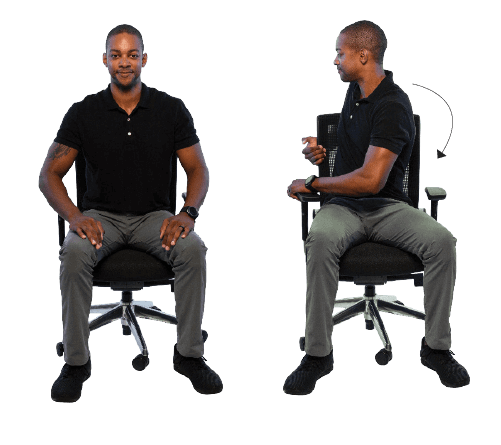
Sit in a chair and hold the left-hand armrest of your seat. Keeping your back straight, turn the right side of your body towards the armrest, and hold for one minute. Then do the same on the other side. To make this lower back stretch even more effective, do the twist with your right elbow pointing into the outside of your left leg, and vice-versa.
This one is great if you’re traveling in a car or on a plane and want to stop your lower back from cramping up.
4. The Pigeon
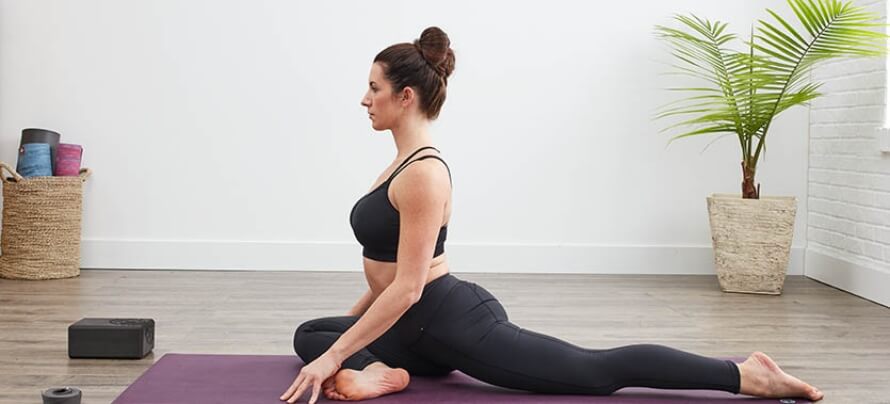
Start off on all-fours and face the ground. Raise your left knee under your chest and point your foot in the same direction as your right hip, so that it’s almost at 90-degrees under your torso. Extend your right leg straight out behind you and rest the top of your foot on the ground, so most of your weight is now resting on your left leg.
Gently turn your torso so your chest is facing straight ahead, place your hands on the floor in front of you, and lean forward, bending at the hips. Keep leaning forward until you feel a stretch in your glutes and lower back, and hold this position for two minutes. Then repeat the same thing on your other side.
5. Legs Up the Wall

Lie on your back and place your feet on a wall in front of you. Scoot closer to the wall, moving your feet upward, until your butt is touching the wall. Breathe deeply, and you should feel all the muscles of your lower back and upper thighs relax. Hold for 10 minutes.
6. Supine Hamstring Stretch
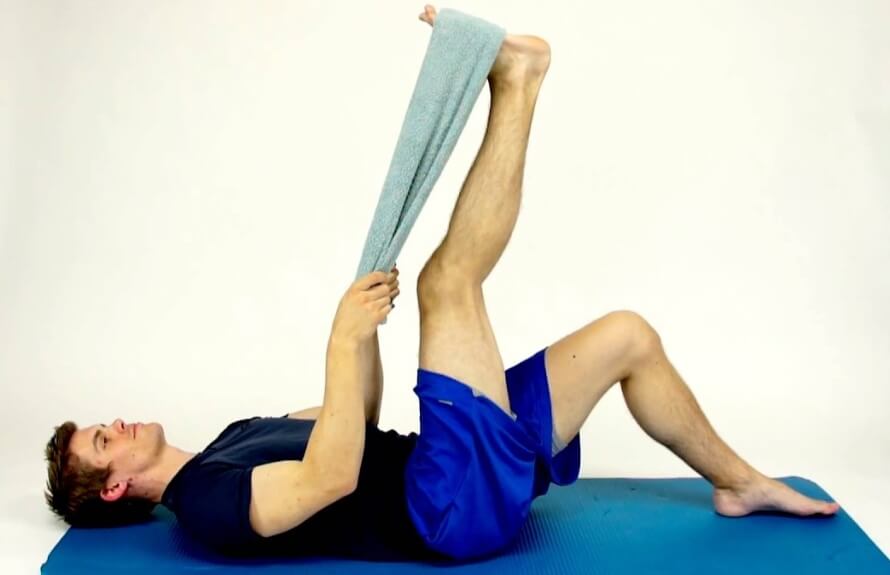
Lying on your back, bend your left knee towards the ceiling, place a towel or strap around your left heel, then straighten the leg, while pressing out through your heel. If your back begins to feel a bit uncomfortable, bend your right knee and place that heel on the ground near your backside for added support.
Hold for three minutes and then repeat with the other leg.
7. Supine Pigeon Pose
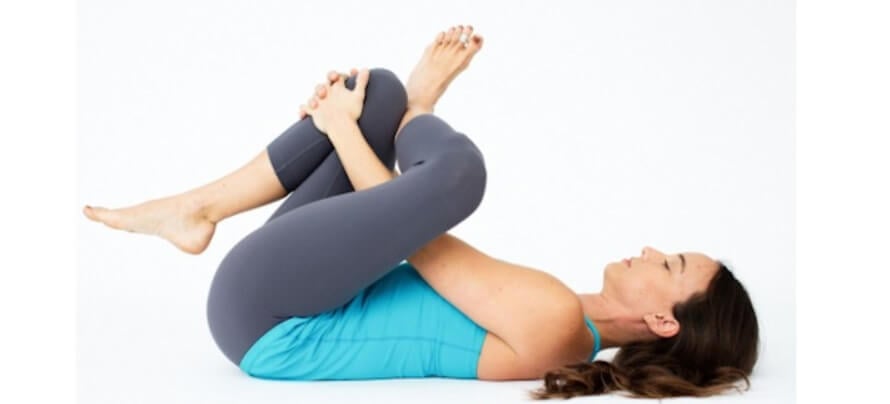
Lie on your back, press both knees together, and bring them to your chest. Place your left ankle on the top of your right knee and clasp your hands over the front of your right knee. Gently pull your right knee toward your chest while pushing your left knee away from your chest until you feel a stretch in your left glute and lower back, and hold this position for two minutes. Then do the same thing with your right leg.
FAQ #1: What is the lower back and why does it hurt?
Back pain comes down to how your muscles, ligaments, and bones interact with each other.
You see, your back is an intricate cluster of:
- 24 small bones that support the weight of your upper torso
- Shock-absorbing discs that cushion the bones and let the spine bend
- Ligaments that clasp the vertebrae and discs together
- Muscles
- Nerves
- Tendons that connect muscles to vertebrae
- A spinal cord, which transmits nerve signals from the brain around your body.
Here’s how a lot of this looks:
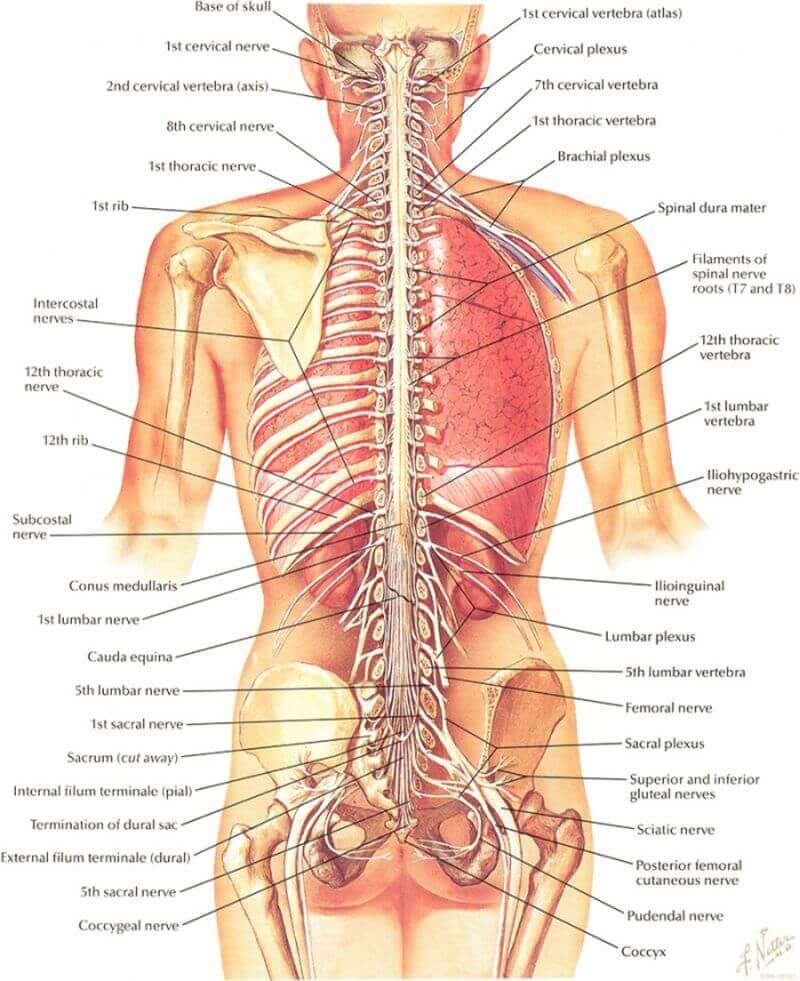
Then there’s your lower back (referred to as the “lumbar” region of the spine), which is where most back pain happens.
It’s composed of five vertebrae, which are the column of small bones that form your spine. Here’s how they look:

Because the lumbar spine is a complex interwoven structure, even the slightest damage to the ligaments, tendons, muscles or discs in this area can cause agony. Sciatica is an example of this. If the sciatic nerve in your lower back gets pinched, pain can shoot down your leg and pulsate for days.
Nerve dysfunction can cause back pain as well. Scientists are still puzzling out exactly how this process works, but the long story short is that irregularities in nerve function can cause severe lower-back pain even when there’s no physical damage to the tissues.
Muscular imbalances may also contribute to lower-back pain. Although there isn’t much conclusive research to prove this, it’s possible that when two or more opposing muscles don’t contract and relax like they should, one becomes weak and slack while the other becomes overworked and tight (that’s the theory, anyway).
In the case of the back, this line of thinking states that the lower back and abdominal muscles fail to work synergistically like they should. Instead, weak lower back muscles force your core muscles to do more than their fair share to hold you upright. This causes your core to get tighter and tighter and pull more and more on your lower back, which eventually results in pain.
If the muscular imbalance isn’t corrected, a vicious cycle ensues: your tight stomach muscles grow ever-tighter, pulling on the lower back even more, exacerbating the pain. Conversely, weak, poorly developed stomach muscles cause the spine to become off-kilter, which can result in lower back pain.
(Again, that’s the idea, but research hasn’t conclusively proven any of this).
If this theory is true, though, the solution is obvious: Strengthen both your core and lower back muscles. If you develop these muscles, it should go a long way in correcting these muscular imbalances and keeping your lower back pain free by giving your spine the muscular support it needs to function properly.
I should also mention that being lean helps as well. Studies show a clear association between obesity and lower back pain. The more top-heavy you are, the harder your lower back is going to have to work. In other words, losing weight is one of the best ways to prevent and reverse lower-back pain.
FAQ #2: Does sitting lead to lower-back pain?
Yes, but not for the reasons most people think it does.
Many people claim that sitting “puts your muscles to sleep” or “weakens” or “shortens” certain muscles, which inevitably leads to lower-back pain. Others claim that over time, sitting undermines your posture and can even permanently damage your spine (they often like to invoke the image of a hunched-back office worker, gawping at his screen and pecking at his keyboard).
The reality, though, is that none of these hypotheses have ever been proven conclusively proven. Instead, these are usually pet theories that prominent chiropractors, physical therapists, and personal trainers use to explain their patient’s lower-back pain (and also conveniently justify their services).
The real reason sitting can lead to lower-back pain, though, seems to be less dramatic: it involves holding the same position for long periods of time.
Research (and common sense) shows that sitting, standing, kneeling, lying on your back, or holding any position for long periods of time can lead to aches, pains, and a number of other health issues. In other words, sitting can lead to lower-back pain, but it’s not uniquely damaging in this regard. Other forms of sedentary behavior can be just as harmful.
The solution? Maintain an active lifestyle, and be sure to get up and move around for a few minutes at least every hour or so of sitting.
Read: How Bad Is Sitting for You, Really? (What 28 Studies Say)
+ Scientific References
- Shiri R, Karppinen J, Leino-Arjas P, Solovieva S, Viikari-Juntura E. The association between obesity and low back pain: A meta-analysis. Am J Epidemiol. 2010;171(2):135-154. doi:10.1093/aje/kwp356
- Han H Il, Choi HS, Shin WS. Effects of hamstring stretch with pelvic control on pain and work ability in standing workers. J Back Musculoskelet Rehabil. 2016;29(4):865-871. doi:10.3233/BMR-160703
- Chatchawan U, Jupamatangb U, Chanchitc S, Puntumetakul R, Donpunha W, Yamauchi J. Immediate effects of dynamic sitting exercise on the lower back mobility of sedentary young adults. J Phys Ther Sci. 2015;27(11):3359-3363. doi:10.1589/jpts.27.3359











